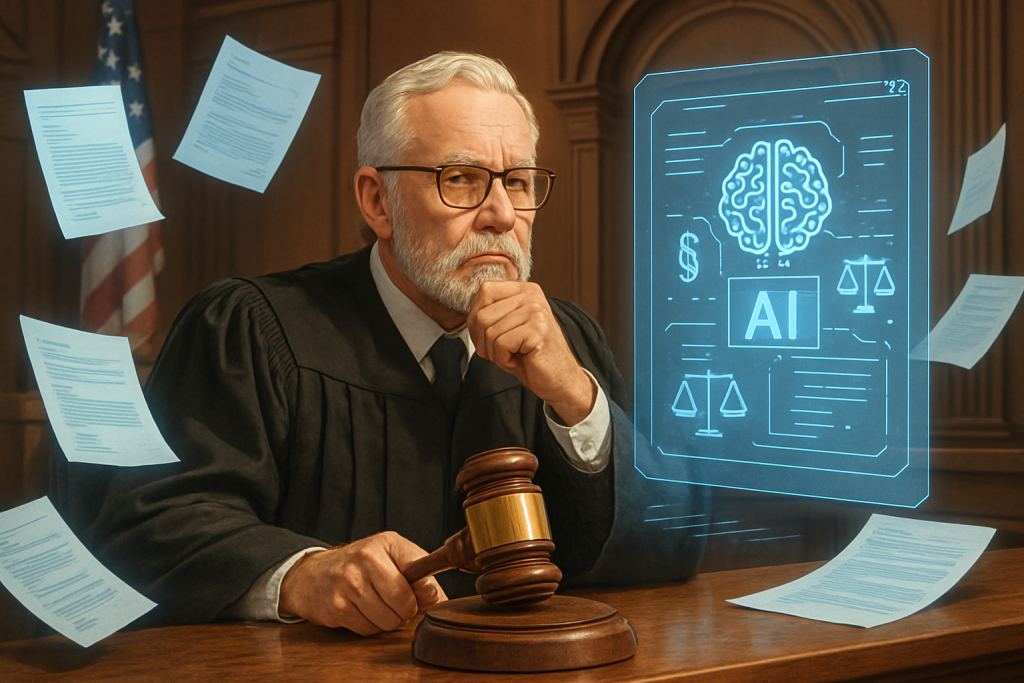The gavel has come down. Not with a resounding *thwack* against polished wood, but with the quiet, almost imperceptible click of a policy update. Yesterday, July 18th, 2025, California, the land of sunshine, silicon, and now, officially, AI-regulated justice, took a giant leap into the future. The California Judicial Council, the body that calls the shots for the state’s massive court system, adopted a groundbreaking rule governing the use of generative AI by judges and court staff. Think of it as Skynet getting a rulebook, or maybe more accurately, Judge Judy learning to use ChatGPT.
But this isn’t some futuristic sci-fi fantasy; this is happening right now, and it’s a big deal. California boasts the largest court system in the United States, a sprawling network handling a staggering five million cases each year. That’s a lot of legal wrangling, a lot of paperwork, and a whole lot of opportunity for AI to potentially streamline, or, if left unchecked, completely derail the pursuit of justice.
So, how did we get here? It wasn’t a sudden, spontaneous decision. The road to AI regulation in the California courts has been paved with both excitement and a healthy dose of trepidation. Remember back in 2024, when generative AI truly exploded onto the scene? Suddenly, everyone was talking about it, from your grandma figuring out how to write sonnets with AI to corporations exploring ways to automate everything from customer service to coding. The courts, naturally, couldn’t ignore the elephant in the room. Chief Justice Patricia Guerrero, recognizing both the potential and the peril, wisely established an AI task force to delve into the implications of AI within the legal system. This wasn’t just about keeping up with the Joneses; it was about safeguarding the very foundation of our legal system in an age of rapidly evolving technology.
This wasn’t a knee-jerk reaction; it was a calculated move, a recognition that the legal system, with its inherent complexities and profound human impact, needed a framework to navigate this new technological landscape. It’s like seeing the first self-driving cars hit the road and realizing you need traffic laws, pronto.
Now, let’s get down to the nitty-gritty. What exactly does this new rule entail? Well, California courts have until September 1st, 2025, to make a crucial decision: either ban generative AI altogether or develop specific regulations governing its use. If a court chooses the latter, they’re required to adopt or adapt a model policy provided by the AI task force. Think of it as “choose your own adventure,” with the adventure being the responsible integration of AI into the justice system.
But it’s not a free-for-all. The rule mandates that court policies address several critical areas that would make even HAL 9000 blush: confidentiality and privacy (no feeding confidential information into public AI systems, obviously), bias and discrimination (ensuring AI doesn’t perpetuate existing inequalities), safety and security (protecting against potential risks), and perhaps most importantly, oversight and transparency (requiring human verification of AI-generated material and disclosure when content is entirely AI-generated). Imagine a future where legal briefs come with a disclaimer: “Written with assistance from AI. Human lawyers still liable for any egregious errors.”
Task force chair and appellate judge Brad Hill has emphasized the need for flexibility, acknowledging that AI technology is evolving at warp speed. He’s right. What’s cutting-edge today could be obsolete tomorrow. The rule needs to be adaptable, a living document that can evolve alongside the technology it governs. It’s like trying to write a user manual for a shapeshifting robot.
So, who does this affect? Well, pretty much everyone involved in the California court system, from judges and court staff to lawyers, litigants, and even the general public. If AI is used to streamline legal research, draft documents, or even analyze evidence, it could potentially speed up the legal process, reduce costs, and improve access to justice. But, and this is a *big* but, it also raises concerns about accuracy, fairness, and the potential for bias to creep into the system. Can an AI truly understand the nuances of human emotion, the complexities of human relationships, or the weight of human suffering? Can it deliver justice, or just deliver data?
California isn’t alone in grappling with these questions. Other states, including Illinois, Delaware, and Arizona, have already established guidelines for AI use in the judiciary. This signals a growing consensus that AI is here to stay, and that we need to figure out how to use it responsibly. It’s a global conversation, a collective effort to navigate the uncharted waters of AI-powered legal systems.
But there’s more to this than just efficiency and cost savings. This development touches on fundamental philosophical and ethical questions about the nature of justice itself. What does it mean to be judged by an algorithm? Can an AI truly be impartial? And what happens to the human element of the legal process, the empathy, the understanding, the ability to see beyond the facts and connect with the human stories behind them? These are questions that philosophers, ethicists, and legal scholars will be debating for years to come.
And let’s not forget the financial implications. The companies developing AI tools for the legal industry are undoubtedly watching this development closely. California’s decision could set a precedent for other states, and even other countries, potentially opening up a massive market for AI-powered legal solutions. But it also raises questions about liability. If an AI makes a mistake, who’s responsible? The developer? The user? The judge who relied on the AI’s output? The legal battles over AI liability are just beginning.
The California Judicial Council’s decision is a bold step, a recognition that AI has the potential to transform the legal landscape. But it’s also a cautious step, a recognition that we need to proceed with caution, ensuring that technological advancements enhance rather than compromise the fundamental principles of justice. It’s a tightrope walk, balancing innovation with responsibility, progress with preservation. And the world is watching to see if California can pull it off.
Discover more from Just Buzz
Subscribe to get the latest posts sent to your email.


